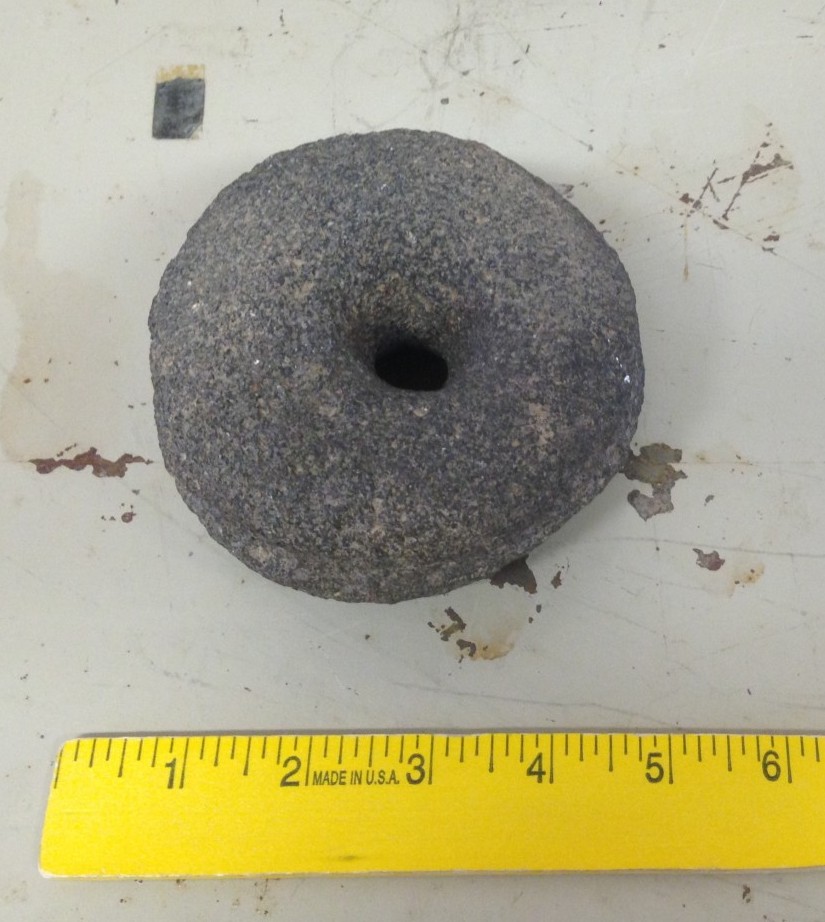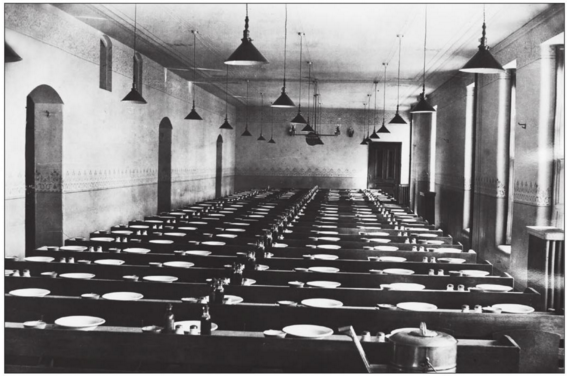This issue: Contents
Tuesday, April 5, 2016
- Editor’s Note
- WCHS News: 75th Annual Warden’s House Open House
- WCHS News: WCHS Internship & Scholarship
- What Is This Thing?!
- Old News: Prison Twine Season
- Featured Article: Visiting the St. Croix 149 Years Ago
Editor’s Note
Howdy e-newsletter readers!
First off,, thank you to everyone who made it out to our Annual Meeting last Thursday! We had a great turn out for Jumpin’ Jim Brunzell! Here’s a quick album in case you missed the festivities.
It’s also time to fire up the fanfare now that we’re a bit less than a month away from the official openings of the Warden’s House and Hay Lake Museums for the 2016 season!
In fact, you can be part of this year’s kick-off event at our 75th Annual Warden’s House – check out our first News Story for all the details!
And don’t skip our second News Story or you’ll miss all the important info about our internship and scholarship programs!
Another challenge (and a quick correction) is waiting for you in today’s “What Is This Thing?!” section.
Scroll down to the Old News segment and you’ll take a look at an often overlooked entrepreneurial element of Stillwater’s state prison.
Now that Spring is on the horizon, Stillwater is once again alive with vacationers from all corners of the Twin Cities. Visiting the city these days is as easy as typing “Stillwater, MN” into your smart phone and hopping on 94. But the Valley has always called to the adventurous spirit!
Check out today’s Featured Article to read a fascinating and detailed first-hand account of a St. Croix River expedition from a century and a half ago!
Want to learn more about the history of Washington County? “Like” WCHS on Facebook and follow us on Twitter!
Sean Pallas
Historical Messenger editor and Warden’s House Site Manager
spallas.wchs@gmail.com
WCHS News
75th Annual Warden’s House Open House
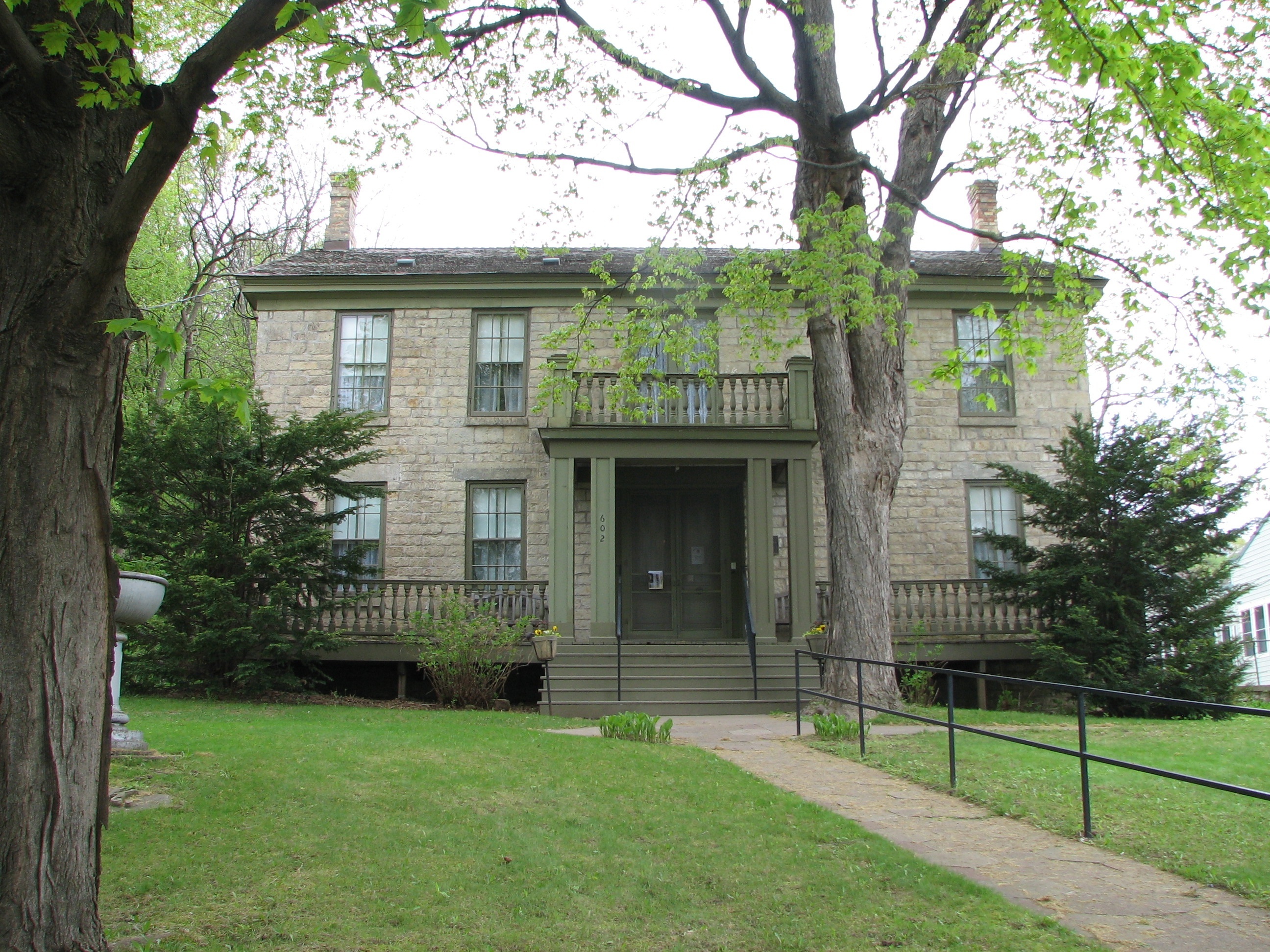 The Washington County Historical Society will launch its milestone 75th touring season at the Annual Warden’s House Open House on Sunday, April 24th from Noon – 4:00 PM! This is a free event.
The Washington County Historical Society will launch its milestone 75th touring season at the Annual Warden’s House Open House on Sunday, April 24th from Noon – 4:00 PM! This is a free event.
At the Open House, you’ll get a sneak peek at the museum’s newest exhibits on early immigrants into Washington County, local “last man’s clubs” of the Civil War and World War I, and the 100th anniversary of the Stillwater High School year book – the Kabekonian.
You’ll also be invited to enjoy live music provided by students of Mary Taylor Allen, sample delicious treats and snacks, and sip on coffee generously provided by Caribou Coffee.
From 1853 to 1914, the Warden’s House was the home of 13 different wardens of the original Stillwater Prison. For the last 75 years, the historic home built by the Minnesota Territorial government has been operated as a Victorian life and prison museum by the Washington County Historical Society.
The Warden’s House touring season runs May through October with tours held Thursdays through Sundays starting on every hour from 1:00 to 5:00 PM
For more information contact Sean Pallas at 651-439-5956 or spallas.wchs@gmail.com.
Other Events
WCHS News
WCHS Internship & Scholarship
The Washington County Historical Society is inviting post-secondary students to apply for a paid summer internship position at the Warden’s House Museum in Stillwater and the Hay Lake School Museum in Scandia. The deadline for applications is April 30th, 2016.
The internship program introduces students to the day-to-day workings of a regional history museum and provides an opportunity to apply academic skills and training in a unique working environment.
Application Process
Please send application letter, resume and two letters of reference by April 30th, 2016 to:
Washington County Historical Society, c/o Internship Committee, P.O. Box 167, Stillwater, Minnesota 55082
Qualifications: The intern must be an undergraduate or graduate student majoring in History or a related field. S/he should have good English and communication skills, be reliable and able to work both as a team member and independently. S/he should have creativity, pay attention to detail, present him/herself well, and enjoy working with the public.
Position Overview: The 10-week internship is a mixture of training and hands-on experience. The intern will be invited to learn about day-to-day operations of a small history museum, including interpretation, exhibit displays and design, collections care and preservation of artifacts. Opportunities will be offered to attend board meetings, participate in fundraising activities, assist with Society sponsored events and contribute to the quarterly newsletter.
Requirements: Interns will be asked to design and complete a project that will benefit both themselves and WCHS.
Supervisory Procedures: The supervisor will work with the intern to set goals, both personal and objective, to be tracked throughout the internship.
The internships are made possible by an annual grant from the DeLonais Foundation.
Scholarship
The goal of the Washington County Historical Society Scholarship program is to encourage historic preservation and interpretation, and to encourage students to study history by providing financial assistance in the form of an educational scholarship.
This scholarship is available to a graduating senior enrolled in a Washington County high school, or a student in a college or university program currently residing in Washington County (as a permanent residence) who is focusing on history, American studies, architecture, or a history-related field of study.
Applications must be submitted before April 30th, 2016.
Please carefully review, complete, and submit the following scholarship application form:
2016 Scholarship Application
Submit applications to:
- Washington County Historical Society
- c/o Scholarship Committee
- P.O. Box 167
- Stillwater, Minnesota 55082
Applicants must also:
- Have a grade point average of 3.0 or higher
- Be a member of the Washington County Historical Society or have an immediate family member(s) who is a member of the Society.
The Scholarship Program is facilitated and managed by the Washington County Historical Society Board of Directors and administered by a designated committee.
The scholarship is made possible by a generous grant from the DeLonais Foundation.
What is This Thing?!

What Is This Thing?! (Round 32)
Last issue’s What Is This Thing?! actually pairs pretty well with the butter mold from two issues ago (which was incorrectly linked in the previous Historical Messenger).
Several readers (especially the Boy Scout alumni among you!) immediately recognized the last item as a Reflector Oven. This contraption would be placed near a camp fire or wood burning stove and allows you to easily bake bread or biscuits! Here’s a video of a modern reflective oven in action.
This particular oven came from Stillwater’s Mulvey family and, in fact, was one of the first items ever donated to the historical society!
Thank you to everyone who participated – even those of you who just make a guess to yourself at your desk!
Let’s move away from the kitchen for this week’s challenge…
Can you identify the WCHS artifact photographed above? Can you guess its use? If you’d care to venture an answer, you can send an email to me at spallas.wchs@gmail.com, tweet @WCHSMN, or post your guess on our Facebook page.
Good luck!
Full Image
Old News
Prison Twine Season
 If I’ve ever shown you around the Warden’s House Museum, you’ll probably have heard me say the following: “I think that when people imagine the ‘Stillwater Prison’ – they picture some sort of Andy Griffith Show sort of scenario; two cells and Barney Fife with his feet up on a desk.”
If I’ve ever shown you around the Warden’s House Museum, you’ll probably have heard me say the following: “I think that when people imagine the ‘Stillwater Prison’ – they picture some sort of Andy Griffith Show sort of scenario; two cells and Barney Fife with his feet up on a desk.”
When in fact, the Stillwater Prison was a very large and professional institutional. At its most crowded, the prison housed anywhere from 550 to 600 inmates. And these inmates housed in the prison had all been sentenced to “hard labor”. At Stillwater this meant factory work.
By 1900, the Stillwater Prison produced 5.5 million pounds of twine annually. It was extremely popular with local farmers as it was made out of high quality Manila hemp, while the low labor costs kept overall prices affordable.
The following is a brief article reminding customers to place their orders sooner rather than later.
Binder Twine Orders – Stillwater Messenger – April 5, 1902
Famers Advised to Make Knows Their Needs While Supply Lasts.
Orders for binder twine are being received in large numbers daily at the state prison. The output is 35,000 pounds per day. Warden Wolfer is mailing about 30,000 circular letters to farmers of the state in which he says:
“We write to remind you that unless your order is at the prison on or before May 1, we may not be able to fill it. First come, first served. As orders are coming in very fast you should order at once if you wish to make sure of your twine from the prison.
“We also wish to advise you that the outlook is for higher prices before the season closes. If you want prison twine at the lowest price at which binder twine will be sold this season, send in your order at once.”
Featured Article
Visiting the St. Croix 149 Years Ago
by Anita Buck
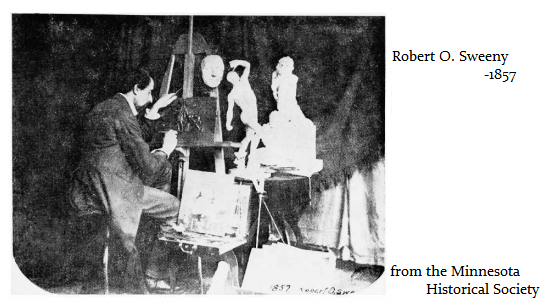 A pencil-written manuscript in the files of the Washington County Historical Society recounts a remarkable canoe trip to the Dalles of the St. Croix. Written by Robert Ormsby Sweeny in June 1867, it details a trip Sweeny and his wife Madge made in company with “my good, trusty old voyageur Antoine Cadotte”.
A pencil-written manuscript in the files of the Washington County Historical Society recounts a remarkable canoe trip to the Dalles of the St. Croix. Written by Robert Ormsby Sweeny in June 1867, it details a trip Sweeny and his wife Madge made in company with “my good, trusty old voyageur Antoine Cadotte”.
Sweeny was a pioneer settler of St. Paul. Born in Philadelphia in 1931, he arrived in St. Paul during the wave of immigration which flowed west in 1852. He was instrument in founding the first Pharmaceutical Society in the state. In 1875, he became chairman of the State Fish Commission, a post he held until his death in 1902.
Art dominated his attention. He made a graphic record of the buildings in St. Paul. He made drawings and paintings of Indian peoples and artifacts. He even designed an unused state seal for Minnesota. He was president of the Minnesota Historical Society for several years. According to an article written by Josephine Lutz-Rollins in the April 1941 Interpreter of the University of Minnesota, Sweeny’s sketchbooks include such events as the openings of the Indian mounds in St. Paul, Carver’s Cave at the time of the Centennial celebration in 1867, and the first and second ice carnivals in 1886 and 1887. Miss Lutz remarked that there were 38 sketches of the trip to Ka Ka Beeka in the collections to MNHS in 1941.
The expedition set out at daybreak on June 1, with Madge and Sweeny both “well-freighted with sketch books, pencils, and perspective”. Both travelers were artists. The party left St. Paul and started down the Mississippi. Madge, on learning that the canoe had no name, suggested it be called La Fliche, “the Arrow”.
Passing beyond Dayton’s Bluff, the party glided through an area of luxuriate bottom grass where herds of cattle grazed. At noon, they stopped at one of the islands for lunch. While Antoine prepared lunch, Madge gathered wild flowers. After a nap, they resumed their journey.
At “the pretty little town of Hastings,” Madge and Sweeny disembarked and walked through the city to the road leading to Point Douglas. Antoine continued by canoe. As the couple marched on, past a saw mill, following a cart road leading over a rough bridge, clouds gathered “in threatening extent and blackness as we entered the forest under the tall arches of whose trees we stalked like specters in the awful hush and twilight of the gathering storm.” Breaking out of the dark and threatening forest, they saw ahead the broad open river. There, a crude ferryboat was readying for its trip across the Mississippi. On board were the ferryman and his helper, a farmer boy driving a pair of cattle yoked to a cart in which sat a countrywoman and a little girl. A black dog sat under the cart. Sweeny and Madge boarded the ferry. Before they reached the opposite shore, the storm broke with crashing bolts of thunder and floods of rain. At the fair side, the ferryman pointed out a house where they “kept folks over night.” Madge and Sweeny made their way to the shelter.
“The public room in which we refuged from the falling rain boasted but scanty and plain furniture. A chair and stove, a long, row rakish looking bench that also answered for a washstand, urging from the bucket, dipper, and tin basin side by side upon one end of it.”
Sweeny sought the proprietor, “a large-framed, large hearted, old-fashioned person, chatty and pleasant, full of quaint kindness and curiosity.” When their hostess learned that Sweeny had his wife with him, she invited them into the parlor. While their hostess and her daughter Sary served tea, the rain stopped. Sweeny went to check on Antoine, and found his bivouac for the coming night. Antoine was disappointed that his passengers planned to stay indoors for the night.
Back at the inn, the Sweenys followed the proprietor’s directions, took their candlestick and climbed the precipitous stairs to a small room with a single curtain-less window. “The clean scrubbed floor was bare, as were also the walls; neither chair, wash stand or any other luxury hampered the limited space of our dormitory.”
While Sweeny looked for a place to stow their belongings, Madge “burst forth in a tone of dismay. There she stood, holding the candle over the bed with one hand, and with the other holding back the sheet she had just turned down.” The bed had been slept in, the sheets were dirty. Concluding to make the best of the situation, the couple decided to spread a large shawl over the bed and pillows, and finally went to sleep without disrobing.
In the morning, Sweeny took one look at the “well-soaked hempen towel” used by the other boarders, and decided to forgo his morning ablutions.
Breakfast over, the travelers started for Antoine’s camp on the St. Croix. “Descending the rocky hill to the sandy point, we got a full clear view of this splendid sheet of water, glittering like a beautiful sapphire beneath the cloudless sun.”
Towards noon, they “put into the mouth of a small stream called the Kinni-Kinnick [sic]”
“Thinking I saw a trout leap, I took a light line from my pack and cutting a small pole, and with Madge’s assistance in the shape of a few small green grasshoppers, I assayed my luck in a shady pool near a large rock. My success was considered complete when I returned within an hour, the captor of twenty speckled beauties,” which Antoine fried to a rich tender juicy brown. Madge discovered a patch of wild strawberries, so “with thankful hearts and keen relish, we sat down to our repast.”
Learning there were two beautiful cascades a few miles up the stream, Sweeny and Antoine scrambled over rocks and fallen trees to the falls. Here Sweeny made several sketches. By the time they returned to the beach, it was too late to continue their journeys, so they pitched a tent for the Sweenys. Antoine crawled under the canoe for his night.
When Antoine learned of Madge’s love of wild flowers, he daily found time to gather some for her. Madge made sketches of the ferns, mosses, lichens and aquatic plants that the voyageur brought to her. She told him the botanical names of the plants, “which gave him extraordinary merriment. His efforts to remember and pronounce the names were most ludicrous. He would laughingly explain ‘No use. No use. Frenchmen’s tongi no say that good like Yankee tongi!”
La Fliche continued up the lake the next morning, and crossed Catfish Bar. Antoine related the legend of the Indian hunter who turned into a fish, then into a sandbar.
Putting in at Afton, the Sweenys ascended the bluff back of the village, “from the top of which there is a panoramic view far down and up the lake.” Both made sketches from their vantage point.
Leaving Afton behind, they reached and passed Lakeland. Again they got out and climbed the bluff, from which they watched the sun “sinking in glorious splendors, casting gleams of amethyst and gold across lake and valley, laced by long shadows from the hilltops.”
Afton a good night’s rest, they crossed the lake to Hudson, “whose pretty little cottage houses nestle cozily back in terraces against the bluffs.” There they procured two horses and a cart, and went to see the falls of the Willow River. A few hours drive brought them to the cascade. There they lingered on the banks of the river to do several sketches. On their return trip, they drove “through a singularly undulating country, abounding in curious ravines and wondrous rocks. Some of them so like ruined Castle wall and Donjon keep, parapet and battlement, that it was hard to realize they were not man’s work.” Descending a slope into a deep valley, they discovered another natural wonder.
“This curiosity is in the form of an immense symmetrically shaped dome of white sandstone, surmounted by a capping of limestone supported upon columnar masses not unlike colossal Carriabides.” Sweeny wrote that, “it glittered in the sunlight with dazzling whiteness like the great Oriental Taj Mahal.”
Leaving Hudson behind, they paddled a few miles up the lake to a sheltered camping sport where they remained for the Sabbath. After reading the Lesson and Collect for the day, they sang several hymns, and spent the rest of the day reading and conversing.
Monday morning the canoeist reached Stillwater, “the most picturesque town of the Lake St. Croix nestled under and against the high rock that buttress-like prop up the overhanging bluffs.” Following one of the zig-zag flights of steps, they climbed one of the tallest hills to view the river.
Sweeny noted that the water here contracts, and becomes the St. Croix River. “As we glide along, we pass a grand facade-like-cliff of creamy grey sand and limestone, wind and weather worn into almost perfect Moorish arches, whose sheltering curve are the fastness where countless sand martins and bank swallows build their young.
“At another point a beautiful shelving rock projects far over the bank bellow … while from its strong eaves a crystal spring distills in glittering drops…”
At Arcola, noted Sweeny, “the river divides into several channels among…islands whose vine clad trees made cool and leafy grottos.”
A short distance further, they passed the mouth of the Apple River, “which here forms quite a lagoon or bayou several miles long and about half a mile wide abounding in waterfowl and fish. There is also quite a pretty water fall on this stream…”
That evening, their dinner was fresh frog legs, caught and cooked by Antoine. Later, “we could see a skiff with standing figures.” A few minutes later, there came into the glare of the campfire, “four sturdy and wholesome looking lumbermen, erect and paddling in time to their songs. They waved their hats cheerily to our greeting.”
Breakfast the next morning included fried fish and fresh eggs, which Antoine had conjured up from a nearby farmhouse. Their day’s paddling brought them into the dalles of the St. Croix. (There was no mention in the manuscript of Marine on St. Croix.) “We stopped and climbed to the foot of a curious pile of ponderous blocks that Antoine assured us is called the Devil’s Chair.” [The Devil’s Chair was toppled by vandals in 2006.]
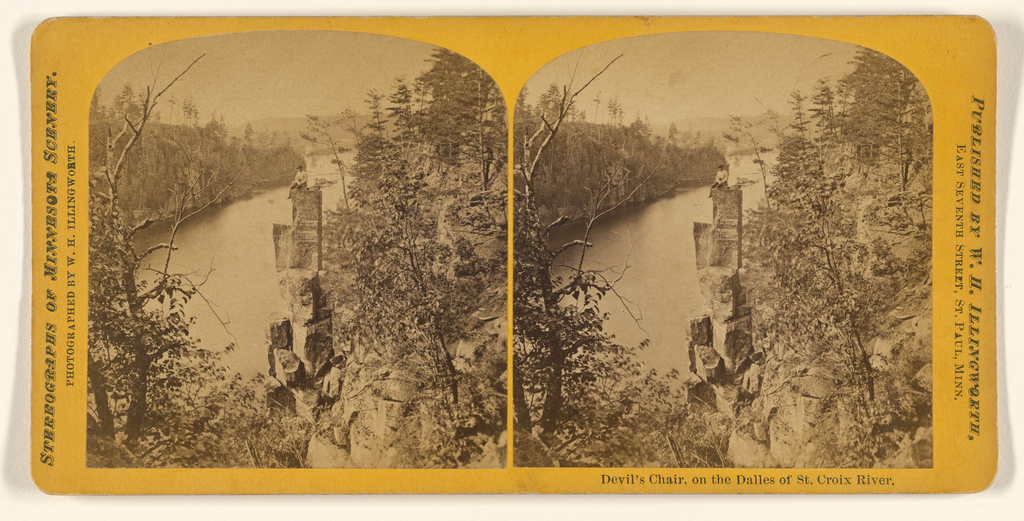
“The river banks are hereabouts a perfect labyrinth of curiosities for those who love to seek them out. We peeped down into strange well-liked circular openings into the very hearts of the rocks…and after climbing an almost inaccessible ravine, we had the temerity to actually walk into and eat our lunch in the bake oven, declared to be the property of his Satanic mastery.
“The St. Croix here is swift, deep and narrow. The water has a dark rich amber color doubtless stained by the roots of the countless pine and tamarack through which many of its tributaries flow.”
Camping that night on an island, Madge found a veritable garden of violets and other wild flowers. Next morning, after breakfasting, they continued their voyage, stopping now and then to sketch and examine the curious rock formations.
Sweeny conclude his narrative: “There are two little villages here at the falls of the St. Croix, one on each side of the river, connected by a dainty fairy-like bridge from one rocky shore to the other. The Minnesota side is called Taylor’s Falls, while Wisconsin side is named St. Croix.”

 75th Annual Warden’s House Open House
75th Annual Warden’s House Open House